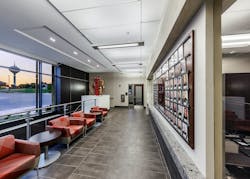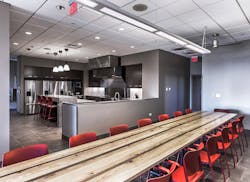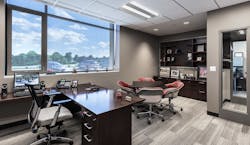Station Design Supplement: Commercial Furniture 101
It is a unique opportunity for a chief to oversee building a new fire station, which generally involves a designer to help outfit the station with new furniture. There are several important factors to consider before purchasing furniture, perhaps the most important being the difference between residential and commercial furniture (aka contract furniture). Fortunately, whether the furniture is for a new station, renovation or a single room, the process is the same. When ordering commercial furniture, you will have to specify the parts and pieces. This specification process will help ensure that you are getting durable furniture that will stand the test of time. Let’s review a series of questions to explore the ins and outs of commercial furniture.
What is the difference between residential furniture and commercial furniture?
Research shows that the average American spends more time at their job then eating, sleeping or with their families. Because of the sheer volume of time spent in the “office,” commercial furniture has to be built to a much higher standard than the furniture we put in our homes. As such, commercial furniture is what belongs in the workplace. Unfortunately, a common pitfall I see is purchasing residential furniture over commercial furniture because of the cost savings. But there is a big difference between residential and commercial furniture, and facilities that operate on a 24/7, three-shift schedule require commercial furniture.It is vital to know where to find commercial furniture, as only a few companies sell both residential and commercial furniture. The designer will choose the appropriate company because each business identifies itself differently. The name of the business will not always indicate the type of furniture it sells. For example, there are the West Elm retail stores, but there are also West Elm Workspace stores, which have commercial or contract furniture. Another example would be La-Z-Boy, which also has a commercial furniture line called La-Z-Boy contract furniture or KNU Contract.
The commercial furniture industry has a “governing” body called the Business and Institutional Furniture Manufacturer Association (BIFMA). It is a not-for-profit organization that has been around since 1973. They assess the comfort, safety and durability of commercial furniture. Residential furniture companies do not have their furniture tested to meet the BIFMA standards. The American National Standard Institute (ANSI) provides the accreditation for BIFMA. This organization comes up with the testing standards for products to protect the public.
What are the different ways to procure commercial furniture?
There are a few different ways to purchase commercial furniture. One easy way is off of state and government purchasing agreements. Agreements such as General Services Administration (GSA), National Joint Powers Alliance (NJPA) or the Cooperative Purchasing Network (TCPN) are a good place to start for commercial furniture purchases. These agreements have been pre-bid to allow government agencies the ability to buy off of and receive competitively priced furniture. The only wildcard is installation, which is easily bid out.
The second way to purchase commercial furniture is by bidding it out. Bidding out is a very time-consuming process, and it does not allow you as much control as buying off of an agreement. You also need to keep in mind that you might be dealing with multiple dealers in the end, so if something were to break or you need maintenance on something, you will need to reach out to the correct dealer.
How do I know if I am getting something that is durable?
Commercial furniture must be purchased through a furniture dealer or manufacturer’s rep. Do not purchase commercial furniture off the Internet. The industry has been set up this way for many years. However, reading and understanding the warranties is always important when buying furniture, especially for a 24/7 facility. It is important to know that even though a company and/or product may be commercial or for contract use, it still might not have a warranty that covers a 24/7, multiple-shift facility. So it is important to read or ask for products that have a warranty to cover the heavy use that a multiple-shift facility will endure. It is also important to understand that the warranty does not always cover the whole chair; it may only cover the parts and pieces. The fabric will then have a different warranty. Warranties do not cover abuse or misuse of the product, or failure from normal wear and tear.
How do I narrow down my search?
Some key things to look for to narrow down the search:
· At least 300-lb. weight capacity
· Meets or exceeds ANSI/BIFMA standards
· Warranty coverage for multi-shift (24/7) applications
· Fabric should meet CAL 133 (flammable retardant/resistance)
· Wyzenbeck fabric durability test (look for 100,000 double rubs or more)
Why are there so many selections for one piece of furniture?
The number of selections for a simple task chair can be overwhelming, let alone a whole room of furniture. However, it is no different from buying a car and making the choice that works for you. Commercial furniture is not something that manufacturers have in stock; it is all made to order.Let’s take the task chair as an example and say we have found a chair that meets all the above requirements. Now, I need to make several choices:
· Mesh back vs. upholstered back: The type of backing is an aesthetic and personal preference. With a mesh back, it tends to be cooler while sitting in a chair for an extended period. The key is to make sure that there is lumbar support.
· High back vs. mid-back: This is an aesthetic and personal preference. Consider the height of those who may be sitting in the chairs. If they are 6 feet tall and above, the high back may be best.
· Fixed arms vs. adjustable arms or no arms: We are all different sizes, so to have this flexibility for ergonomics is critical. Having this adjustability also helps with the longevity of the furniture. When someone first sits in their task chair, they adjust the height to fit their body. It is helpful to have the ability to change the arms to fit their body so that when pushing in the chair, the arms do not hit the desk or table and damage the edges. Depending on how often you need to move around or how you wear your radios, it may be helpful to have no arms.
· Seat depth adjustment or none: Again, with everyone being different heights, it is imperative that the ability to adjust the depth of the seat, so that the edge of the seat hits just behind the knee joint with your thighs parallel to the floor.
· Hard casters or soft casters: Casters are all about the ease in how the chairs move. Different flooring surfaces require different caster types. If the chair will be on carpet, it is important to have hard casters for the ease of movement. If the chair will be on a hard flooring surface, it is important to have soft casters so that there is a more controlled movement with the chair.
What are the health factors to consider?
Basic ergonomics in a task chair is a given today. However, adding a sit-to-stand desk, walking station or a bike station goes a long way in the health of your employees.
Of course, there are many different—and deeper—layers to health in the workplace today. The Well Building Standard is a system to help guide the design, uses and behaviors within the work environment to improve the health and well-being of its occupants. It looks at air quality and levels of volatile organic compounds (VOCs), which are linked to cancer and other health issues. VOCs affect our cardiovascular system, nervous system, respiratory and immune system. This evaluation is important because VOC levels can be five times higher indoors than outdoors. Designers will look at several station elements for these reductions, including interior paints and coatings, interior adhesives and sealants, flooring, insulation, and furniture and furnishings.
Most commercial furniture is held to the higher testing standards below, and should be tested by these standards:
· ANSI/BIFMA e3-2011 Furniture Sustainability Standard (Sections 7.6.1 and 7.6.2), tested by ANSI/BIFMA Standard Method M7.1-2011
· California Department of Public Health (CDPH) Standard Method v1.1-2010
The Well Building Standard also looks at how environments affect our mental wellbeing. One simple but notable example is when outfitting workstations for an office, make sure that the employees back isn’t to the door or walkway. As humans, we feel most in control and safe when our backs are up against a wall, allowing us to see what is coming. You can trace this over thousands of years with human behavior.
It is also important to research the manufacturer whose products you wish to purchase. What type of materials do they use? How much off-gassing will the products have? Are the surfaces anti-microbial? Are they easy to clean? Material quality is a small part of a broader topic, but each manufacturer will have answers to these questions.
Is there an added benefit of having a designer help?
There are many benefits to having a designer assist on furniture projects. First, they know all the details, yet are looking at the overall larger picture. One example of this is the designer will coordinate the electrical with the furniture, and make sure the overall design and finishes are functional for the application. Finishes are not just about the “look”; they are really about the durability and how it will function in a space. For example, stainless steel sounds like great material for durability, but it is loud. Designers can help with layouts and space planning while explaining how it will impact your operations. They can also bring samples out or take you to a nearby showroom.
In sum
As you can see, there is a lot of testing and standards that go into contract furniture. These tests and standards help protect the health and well-being of people in the workplace. Commercial furniture is costlier than what you might buy from a website or a residential manufacturer; however, the added value that you receive in durability, longevity and safety is well worth it, just like the old saying “you get what you pay for.” It is also important to keep in mind that furniture can truly influence the culture and operations of the station. Often there is a furniture solution that can influence a culture shift that will help solve the issue.

Raegan Porter
Raegan Porter is a registered interior designer with a diverse background in recreation, municipal, educational and contract design. She is the Municipal Interior Design Leader for FGM Architects. Porter has a unique ability to understand her client’s needs and incorporate them into creative, functional space plans. Through materials, furniture, lighting and art work, she brings her clients vision to life. Her goal for clients is to create an overall experience for the communities using her spaces.








